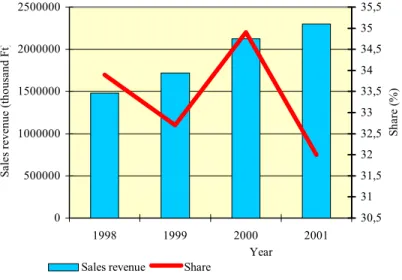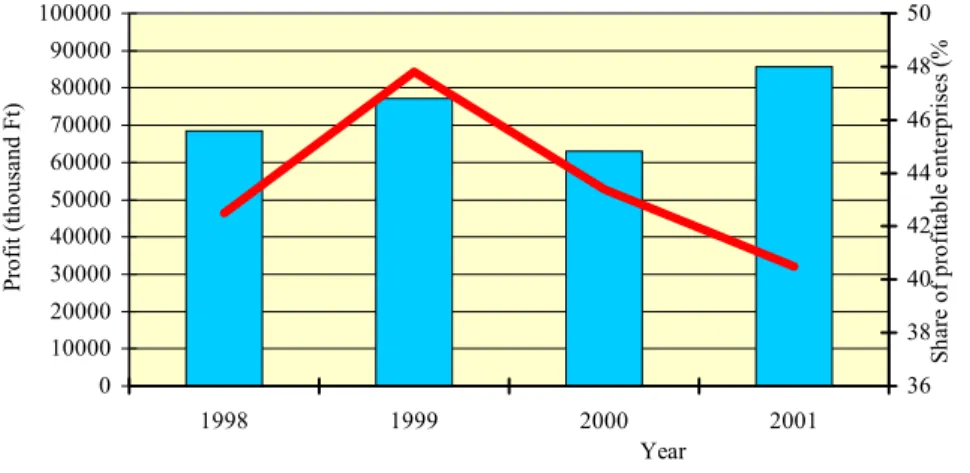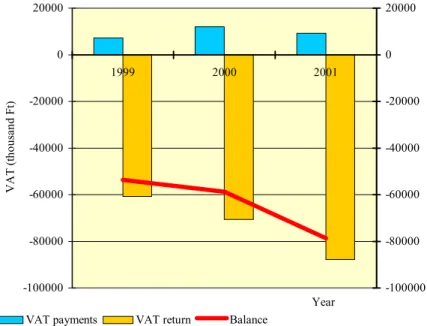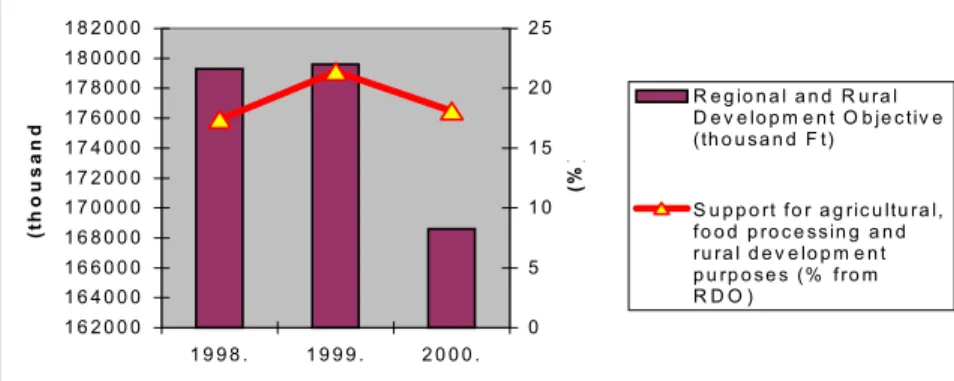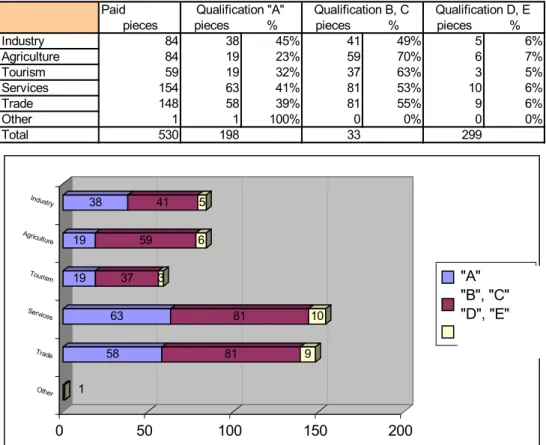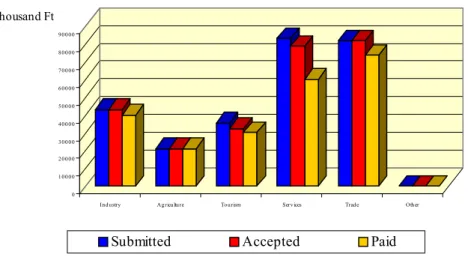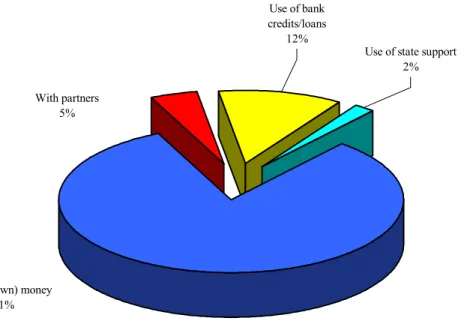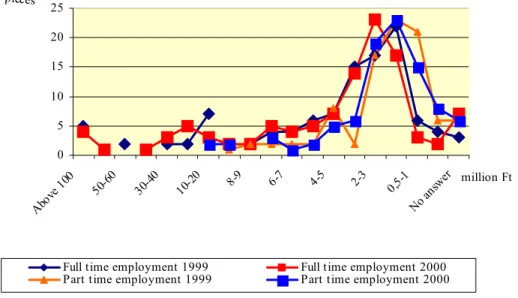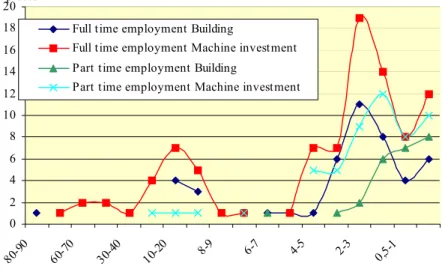DOCTORAL (PhD) THESIS UNIVERSITY OF WEST-HUNGARY
FACULTY OF AGRICULTURAL AND FOOD SCIENCES MOSONMAGYARÓVÁR
Program leader:
DR. SCHMIDT, JÁNOS
University teacher, correspondent member of the Hungarian Academy of Science
Sub-program leader:
DR. TENK, ANTAL
University teacher, candidate of agricultural sciences Theme leader:
DR. TENK, ANTAL
University teacher, candidate of agricultural sciences
FINANCING OF ANIMAL KEEPING SMALL-SCALE ENTERPRISES IN GYŐR-MOSON-SOPRON COUNTY
Written by:
KOCSISNÉ ANDRÁSIK ÁGOTA
MOSONMAGYARÓVÁR2004.
1. INTRODUCTION
If someone wants to describe Hungary’s economy during the last fifteen years, the changes that covered almost all fields of economy could be emphasized. It seems that the country was willing to make up for what it missed in the past 50 years since 1945 – to be able to take its place in the united Europe –, rapid changes happened after the ’89 system transformation. These changes in the national economy affected primarily the agricultural sector. As a consequence of the changes, the majority of those who worked as employees in the ‘80s became agricultural entrepreneurs during the ‘90s, primarily due to the pressure of circumstances. Due to compensation and privatisation property circumstances also changed. Meanwhile the agricultural public opinion and the politics held vivid debates on strategic questions of the agriculture and on the required future development directions. The considerable interest is understandable as agricultural production does not only satisfy the requirements of competitiveness, efficiency and profitability, but it is directly connected to rural development, environmental protection and employment possibilities of a high share of the population. Therefore all decisions concerning agriculture should be thoroughly examined in a complex way.
The ‘90s are often described as the period of system transformation – many prefer the expression of system change – and this period could be characterized by continuous changes, regarding all segments of the
institutions, organisations and services have been introduced from day to day in order to satisfy the information needs of the entrepreneurs.
Besides information human relations became even more important;
especially concerning bank loans and agricultural support decisions.
Entrepreneurs started to learn the lesson: they receive state support or bank loans in case requests are handed in and they are well-explained, and also the use of support is proper and based on the regulations in force.
Financing agricultural entrepreneurs is a complicated question even in the developed capital countries. The proper selection of support objectives is especially important. In Hungary several hundred million Forint have been used from the national budget to support agriculture, but the support only resulted a minor development regarding investments and production results by the end of the ‘90s. However the production level of the period before the system transformation could not even be approached, neither concerning developments or production results, yields. Regarding credit/loan issues both financial institutions and entrepreneurs got to a difficult situation. Due to the lack of own capital and as a consequence the missing loan security the operation of the national institution of loan-guarantee seemed to be the most efficient solution.
This topic is an actual field of research especially nowadays for all those who are interested, in the period of our EU accession. As a member of the EU the whole country – including agriculture – finds itself in the situation of global competitiveness; on basis of the present capital conditions the country will not be able to hold the ground. Therefore all
possible tools should be investigated and utilized in order to improve the competitiveness of small- and medium size enterprises that are still in a capital deficient situation.
After the system transformation during the changes that characterized the agricultural sector several farms, agricultural holdings of different size were established. These companies differed not only in size, but they also started their operation among very different circumstances. At the establishment these companies covered the capital need from own property, compensation, cooperative share or in most cases from the combination of all these elements.
Only a minority of small-scale enterprises and family farms started their business with the involvement of outside capital. There might be several reasons for that:
• the entrepreneur only considered his own available capital,
• he was not aware of the available credit/loan and support possibilities,
• fear from higher risk that comes with a larger farm (company),
• at the time of establishment no outside possibilities were available,
• at the time of establishment the entrepreneur was not solvent.
Besides capital reliable and up-to-date information and also market possibilities to sell the produce are needed in order to establish and operate a profitable company. These factors are especially important for agricultural enterprises, as the return of capital could take years in case of
correct unsuccessful development or business decisions, making these decisions even more risky.
There were difficulties not only on the side of the enterprises, but also regarding the condition system of operating the companies. All ruling governments after the system transformation provided more or less support for agricultural companies and enterprises. However, entrepreneurs needed time to get acquainted with the management of the enterprise. On the other hand governments had to learn how to offer suitable programs from the limited sources available, and how to help the achievement of the objectives. To fulfil the EU requirements means an increasing challenge for both sides.
In Hungary everybody is aware of the fact the financial possibilities for agriculture (sources) are insufficient, although farmers with enough capital and operating a profitable enterprise are in a relatively better position for example in case of bank loan requests. This situation has been characteristic since the beginning of the system transformation (1989) and it specially afflicts animal keepers and producers of animal products. It even applies in those regions – such is the case in Győr- Moson-Sopron county – where animal keeping (cattle, pig) has long traditions and the level of production (yields and other results) are more favourable than the national average.
During the first half of the ‘90s a considerable number of new agricultural small-scale enterprises and family farms have been established in Győr-Moson-Sopron county. Due to the favourable conditions (production, technical, income possibilities etc.) the new enterprises started their operation among better circumstances than the
national average. However, the available sources (from privatisation, compensation and cooperative share) ensured enough cover for a high- level and development-oriented farming only partly and temporarily.
Special attention should be paid to enterprises dealing with animal keeping or production of animal products, as the animal sector requires relatively larger amount of bound capital and production cycles are longer (as a consequence, the return is slower). Most animal products have smaller equipment- and cost related profitability, therefore animal keeping is a more risky activity compared to other agricultural sectors. At the same time circumstances (animal space capacity, fodder producing area, expertise, food processing capacity etc.) could facilitate a higher level (more profitable) and higher volume animal keeping activity in the county. One – not the only, but the most important – limit of this development is the lack of capital.
For today it became evident that without own sources and outside sources involved in the past ten years there is no chance to assist the present state of agriculture or help small-scale enterprises in their unfavourable situation. Small-sale and medium sized enterprises play a determinative role in the agricultural policy of the EU. This situation could only be reached with well-operating and profitable enterprises; at the moment the majority of Hungarian farms do not belong to this category.
The above-outlined circumstances and our EU accession give reasons why facts should be revealed and evaluated thoroughly in order to help to determine and establish the presently missing conditions that are necessary for the development of agricultural small-scale enterprises.
This necessity motivated the selection of the topic and at the same time indicated the possible direction and objectives of the research.
The basic objective was the elaboration of a finance system that ensures profitable operation for small-scale animal farms in Győr-Moson-Sopron county, to draw a general model for the finance system. In order to achieve this objective the following sub-objectives should be reached:
• introduction of the general state of animal keeping both in the county and on national level;
• introduction of small-scale animal farms, evaluation of their results;
• investigation of the present state of animal keeping in the county in question, with special emphasize on the present state and circumstances of small-scale farms, outline of the possible development directions;
• introduction of sources (volume and composition) necessary for the developments of small-scale farms in the period after of our EU accession;
• methods and sources of finance of small-scale animal farms;
• outline the possible finance model for small-scale animal farms operating in the county after the EU accession.
2. MATERIAL AND METHOD
2.1. The environment of the researchResearch related to the development and financial issues of small-scale enterprises were carried out with the assistance of the Kisalföld Business Assistance Foundation (hereafter abbreviated as KBAF) in the period of 1991-2002. During the past ten years several research programs were running concerning the operation of agricultural small-scale enterprises of the county. The KBAF published a study with the title of “Agricultural feasibility study” in 1993 and the “Agricultural source coordination program” study in 2001. The first study introduces a program development program for the period after the system transformation, whole the source coordination program primarily deals with the financial possibilities and situation of agricultural enterprises.
During the ‘90s the KBAF published several professional papers and booklets primarily for agricultural entrepreneurs, in order to find answers to practical questions. Besides the publishing activity many events and training programs were organised.
The KBAF deals with the financial issues of small-scale enterprises since 1993, namely with the realisation of the so-called micro-credit. In the frame of this program the investigation of the credit possibilities and situation of agricultural small-scale enterprises became possible.
2.2. Utilisation of experiences
The investigation of finance issues was assisted by several domestic and foreign study tours, the main objective of these study tours was data collection, but the collection of experiences and professional ideas was also important. In Denmark and in the USA the operation of local agricultural enterprises was investigated, paying special attention to financial questions and circumstances. In Austria the operation conditions and farming (financial) situation of agricultural small-scale enterprises was investigated through the example of several milk farms.
The main line of investigation concerning the Hungarian small-scale farms was the participation on professional events organised by county entrepreneurial centres, and the evaluation of experiences of these centres concerning the micro-credit.
2.3. Data collection and processing
During the evaluation and processing of bibliographical background emphasize was put on the investigation of circumstances and situation of agricultural enterprises after the system transformation. Publications and papers listed in the Bibliography facilitated the getting acquainted to and evaluation of credit and finance problems of Hungarian small-scale agricultural enterprises.
Data supporting the introduction of the macro-economical circumstances originate from the regular publications of the Central Statistical Office.
The evaluation of the present state of small-scale enterprises was assisted by the statistical-evaluative publications of the Research and Informatics Institute of Agricultural Economics, and the yearly reports of the Development Institute of Small-size Enterprises.
Support possibilities of the EU pre-accession funds were introduced on basis of publications of the EU Delegation and the Hungarian Business Assistance Fund.
The referred acts, regulations and up-to-date materials originate from the KERSZÖV Collection of legal materials CD.
The evaluation of agricultural small-scale enterprises operating in Győr- Moson-Sopron county was performed with the use of the SWOT analysis method.
The chapter “Own investigations” introduces the agricultural credit and support possibilities; these investigations are supported by a several years’ data collection. Among the credit/loan investigations the most important information was provided by the micro-credit program of the KBAF. National data concerning agricultural credits are coming from the data base of the Hungarian Business Assistance Fund; county data originate from the County Entrepreneurial Centres. During the research data collection was a continuous task, such as the registration and organisation of these data with the use of IT. The majority of tables were drawn by the MS Excel program.
To investigate agricultural support possibilities data from the Ministry of
Agriculture and Rural Development, County Regional Development Committee have been used. Data have been processed and evaluated with computer software.
The financial circumstances and situation of small-scale animal farms were investigated on basis of data provided by the Győr-Moson-Sopron County Office of the Tax- and Financial Control Office (TFCO). Data have been collected from income tax return papers of private enterprises (1998-2001); data processing has been assisted by statistical methods.
Credit guarantees related to small-scale entrepreneurial credits have been investigated on basis of data of the Agricultural Entrepreneurial Credit Guarantee Foundation; data have been processed with the MS Excel program.
2.4. Questionnaire survey
In order to reveal the present situation of agricultural small-scale farms in Győr-Moson-Sopron county, a questionnaire survey has been performed.
Questions of the questionnaire are listed in Appendix 6. Main topics:
• circumstances at the establishment of the enterprise;
• main fields of activity volume of production and sales;
• outside sources used by the enterprise, credits/loans, supports;
• personal opinions regarding some important agricultural questions.
Investigations have been carried out in 2000 and 2001. Questionnaires were filled in by 200 farmers on spot with the assistance of village
consultants. Farmers were selected randomly, based on the professional experiences and knowledge of the location of the village consultants.
Data have been processed and evaluated with computer software, with the application of mathematical statistical methods.
3. RESEARCH RESULTS
3.1. Investigation of small-scale animal farms / enterprises on the turn of the millennium
Sales value of small-scale animal farms reached 2,3 billon HUF in 2001.
That means a 32 % share from the sales of all agricultural enterprises operating in the county. During the investigated period (1998-2001) sales from the animal keeping sector takes one third from the total agricultural sales on the average in Győr-Moson-Sopron county (Figure 1).
Source: Personal income tax registration forms of entrepreneurs in 1998-2001 (TFCO)
Figure 1: Sales revenue of small-scale animal keeping enterprises
Profit of animal keeping family enterprises fluctuated between 1998 and 2001; in 2001 the number of profitable enterprises decreased, but the
0 500000 1000000 1500000 2000000 2500000
1998 1999 2000 2001
Year
Sales revenue (thousand Ft)
30,5 31 31,5 32 32,5 33 33,5 34 34,5 35 35,5
Share (%)
Sales revenue Share
amount of profit increased. The amount of profit was 25,3 % higher in 2001 than in 1998.
0 10000 20000 30000 40000 50000 60000 70000 80000 90000 100000
1998 1999 2000 2001
Year
Profit (thousand Ft)
36 38 40 42 44 46 48 50
Share of profitable enterprises (%
Profit Share of profitable enterprises
Source: Personal income tax registration forms of entrepreneurs in 1998-2001 (TFCO)
Figure 2: Profitable small-scale animal keeping enterprises
The rate of profitable enterprises was between 40 and 48 % in the investigated period, compared to the number of total enterprises. By 2001 the share of profitable enterprises fell under the 198 level (Figure 2).
The rate of loss-making enterprise fluctuated between 40-50 % during the investigated four years, compared to the number of total enterprises.
By 2001 the number of loss-making enterprises was a little les than in 1998.
Budgetary relations of small-scale animal keeping enterprises
In 2000 the paid sales tax (VAT) was higher, in 2001 it was less than paid in the previous year. In 2001 the amount of paid tax was 27,9 % higher than in 1999. At the same time the amount of required and returned sales tax exceeded payments multiply, and its amount increased from year to year. In 2001 the amount of tax required back and returned to the entrepreneurs was 44,5 % higher than in 1999 (Figure 3).
-100000 -80000 -60000 -40000 -20000 0 20000
1999 2000 2001
Year
VAT (thousand Ft)
-100000 -80000 -60000 -40000 -20000 0 20000
VAT payments VAT return Balance
Source: Personal income tax registration forms of entrepreneurs in 1998-2001 (TFCO)
Figure 3: VAT accounts of small-scale animal keeping enterprises
Small-scale animal keeping enterprises were net VAT refund requiring enterprises, and the amount of the required refund increased
continuously. Net refund was 46,7 % higher in 2001 than in 1999. This tendency of budgetary relations bought a continuously positive balance to the small-scale animal keeping enterprises.
During the investigated years 27-30 % of animal keeping enterprises have paid different forms of tax into the national budget. Almost quarter of all tax payments originated from animal keeping small-scale enterprises.
47-63 % of the animal keeping small-scale enterprises received state support for different reasons. Almost quarter of all support went to animal keeping small-scale enterprises (Figure 4).
0 20000 40000 60000 80000 100000 120000 140000
1998 1999 2000 2001
Year
Amount of statesupport (thousand Ft
40 50 60 70
State support Share of beneficieries
Source: Personal income tax registration forms of entrepreneurs in 2001
Figure 4: Share of small-scale animal keeping enterprises from national supports in 2001 (in %)
It is proved that the amount of national support exceeded the amount of budgetary payments of the enterprises considerably, namely small-scale animal enterprises are supported also in this way. If we compare the amount of support and the amount of payments it can be stated that the difference between these two amounts are higher than the amount of profit produced by the sector.
3.2. Share of agriculture from the Regional Development Objective, from the micro-credit program and from the programs of the Agro- entrepreneurial Credit Guarantee Fund
During the period of 1998-2000 527,5 million Forint was available for different regional- and rural development programs, in the authority of the County Regional Development Committee (hereafter abbreviated as CRDC). From the total amount 100,182 thousand HUF was awarded for agricultural purposes, which was 20 % in the support portfolio. This amount has been divided among 36 agricultural enterprises for animal keeping, plant production, food processing developments and purchase of agricultural machinery.
In most cases sources were combined; the most popular way was the use of machinery purchase and regional development support possibilities, combined with a credit with favourable interest rates (Figure 5).
1 6 2 0 0 0 1 6 4 0 0 0 1 6 6 0 0 0 1 6 8 0 0 0 1 7 0 0 0 0 1 7 2 0 0 0 1 7 4 0 0 0 1 7 6 0 0 0 1 7 8 0 0 0 1 8 0 0 0 0 1 8 2 0 0 0
1 9 9 8 . 1 9 9 9 . 2 0 0 0 .
(thousand
0 5 1 0 1 5 2 0 2 5
(%)
R e g io n a l a n d R u ra l D e v e lo p m e n t O b je c tiv e (th o u sa n d F t)
S u p p o rt f o r a g ric u ltu ra l, f o o d p ro c e ssin g a n d ru ra l d e v e lo p m e n t p u rp o se s (% f ro m R D O )
Source: MTT
Figure 5: Share of agriculture from the Regional Development Objective
The Kisalföld Business Assistance Foundation joined the national micro- credit program in 1993. The number of entrepreneurs interested in the program was similar to the interest arose in other counties; yearly 200- 250 enterprises were interested. Due to the low ceiling amount of the micro-credit (1.300 thousand HUF) the number of interested entrepreneurs decreased in 1998-1999. Credit applications were well- prepared and were filed in according to the regulations set in the Micro- credit Rules; during controls carried out on the locations the manager who submitted the application represented the enterprise. As a consequence 83 % of the applications were accepted. 15 % of the accepted applications arrived from agricultural enterprises. Compared to other sectors, higher interest rose from the services (27 %) and trade (29
%) (Figure 6).
Trade 29%
106.317 thousand Ft
Other 0%
1.000 thousand Ft
Industry 17%
61.168 thousand Ft Agriculture
15%
54.600 thousand Ft
Tourism 12%
45.826 thousand Ft Services
27%
98.958 thousand Ft
Source: Kisalföld Business Assistance Foundation
Figure 6: Share of paid credits by sector and amount in Győr-Moson-Sopron county
Regarding pay-backs the statistics in Győr-Moson-Sopron county show a more favourable picture than the national average. 75 % of the credits were free from any problems, and only 6 % had an overdue debt longer than 180 days (1999) (Figure 7).
Paid
pieces pieces % pieces % pieces %
Industry 84 38 45% 41 49% 5 6%
Agriculture 84 19 23% 59 70% 6 7%
Tourism 59 19 32% 37 63% 3 5%
Services 154 63 41% 81 53% 10 6%
Trade 148 58 39% 81 55% 9 6%
Other 1 1 100% 0 0% 0 0%
Total 530 198 33 299
Qualification "A" Qualification B, C Qualification D, E
1
58 81 9
63 81 10
19 37 3
19 59 6
38 41 5
0 50 100 150 200
Indus try Agriculture Tourism Services Trade Other
Adatsor1 Adatsor2 Adatsor3
"A"
"B", "C"
"D", "E"
Source: Kisalföldi Business Assistance Foundation
Figure 7: Participation of agriculture in the qualification categories
Pressure increased on the Hungarian Business Assistance Foundation – the organisation that was entrusted with the management and control of the program – to take care for the further development of the program.
Due to the low credit ceiling and long-lasting office-work the popularity of the micro-credit decreased considerably by 2000 among the small- scale enterprises. In 2000 the micro-credit program has been renewed and
July 2000 the credit ceiling was increased to 3 million HUF, from the 1st of October 2001 to 6 million HUF, of the required amount 50 % could be used to finance current assets.
Credit term varied between 6 months to 3 years, then with the introduction of the 6 million HUF ceiling it was lengthened for 5 years.
In case the applicant required, a 6 months period ‘days of grace’ could be given. As a consequence of the year 2000 changes the number of those clients who require the micro-credit several times increased in the practice of the KBAF.
0 10 00 0 20 00 0 30 00 0 40 00 0 50 00 0 60 00 0 70 00 0 80 00 0 90 00 0
thousand Ft
Ind ustry Agriculture To urism Serv ices Trad e Oth er
Submitted Accepted Paid
Source: KBAF
Figure 8: Share of the different sectors from the micro-credit in 2001
In 2000 96 enterprises have submitted their application for the micro- credit program of the Kisalföld Business Assistance Foundation, altogether in 173 million HUF value. The share of agricultural enterprises was 6 % from the whole. In 2001 101enterprises have handed in their
credit application in the value of 264,6 million HUF. The share of agricultural enterprises was 8 % (Figure 8).
The guarantee for the credits of agricultural small-scale enterprise applicants was ensured by the Agro-entrepreneurial Credit Guarantee Foundation. Similar to the national data the number of guaranteed credits increased in 2001 in Győr-Moson-Sopron county, from the former 30 to 100. Parallel to this tendency the amount of guaranteed credit increased to 1114 million HUF, but the amount of an average guaranteed credit stayed unchanged (11 141 thousand HUF) (Table 1).
Table 1.
Number and amount of guaranteed credits in Győr-Moson-Sopron county
Year Amount of guaranteed credit, thousand HUF
Average guaranteed credit,
thousand HUF
Number of guarantees
1998 325 972 12 073 27
1999 234 953 7 579 31
2000 373 846 9 838 38
2001 1 114 118 11 141 100
Source: Agro-entrepreneurial Credit Guarantee Foundation
Among the number of guaranteed credits the share of animal husbandry varies between 11-17 % during the investigated four years. The amount of an average guaranteed credit is similar to the amount characteristic to
3.3. Investigation of the financial situation of small-scale enterprises with a questionnaire survey
The investigations covered the whole area of the county; altogether 200 farmers were asked with the help of village consultants.
The selection of the agricultural enterprises to be asked was randomized;
the basic objective was to cover the whole area of the county.
Investigations were carried out in 1999 and 2000. The questionnaire contained the following man topics:
• general characteristics of the agricultural small-scale enterprise (information concerning the establishment, activity and legal form of the enterprise);
• introduction of the sales revenue and investment activity of the enterprise;
• utilisation of outside capital (credits/loans, state support, guarantees).
The most important results of the research:
95 % of the enterprises were established with family cooperation and on basis of personal (individual) decisions (Table 2).
Table 2.
Initiation of the enterprises
Name Number of enterprises
On basis of personal (individual) decisions 77
Family cooperation 108
Involvement of other partners 9
Personal decision and family cooperation 6
Source: Own investigation
To start the enterprise mainly family money (capital) has been used (81
%), and only 11,5 % required a bank credit/loan to get started (Figure 9).
Use of state support 2%
Use of bank credits/loans
12%
With partners 5%
Private (own) money 81%
Source: Own investigation
Figure 9: Financial sources of the investigated enterprises
Only 5 % of the investigated 200 agricultural enterprises is engaged exclusively in animal keeping, almost half of the questioned farms conduct both plant production and animal keeping activities. On basis of the data it can be stated that the same enterprise performs many different activities in order to avoid the negative changes in profitability of certain products, risking the operation of the enterprise.
36 % of animal keeping enterprises deals with cattle (30 % milking cows and 6 % beef cattle), 51 % with pig production; the remaining 13 % is distributed among other animal species.
Entrepreneurs indicated the following priority list regarding those activities that ensure the highest sales revenue:
Cereals, industrial crops: 51%
Animal keeping: 31%
Horticultural products, fruits and vegetables: 16%
Agricultural services: 2%.
The order and the rate were the same in both years; therefore we came to the conclusion that the answering entrepreneurs dealt with a similar field of production (activity) during the investigated period.
Approximately 55-60 % of the enterprises take place in the category of under 3 million HUF sales revenue.
Those enterprises that required any kind of support, with a few extension their application was accepted.
The share of family and other friend credits used within the enterprise is relatively high; more than fifth of the asked entrepreneurs lived with this form of finance.
0 5 10 15 20 25
Above 10 0
50-60 30-40
10-20 8-9 6-7
4-5 2-3
0,5-1
No answer million Ft pieces
Full time employment 1999 Full time employment 2000 Part time employment 1999 Part time employment 2000
Source: Own investigation
Figure 10: Net sales revenue of enterprises
72 of the asked 200 enterprises had investments in buildings in the previous 5 years, of which 25 (that is 35 %) invested less than 1 million HUF, 35 (49 %) invested 1-5 million HUF, 6 (8,3 %) invested 5-10 million HUF and 4 (6 %) spent 10-20 million HUF into building investments.
149 (74 %) purchased machinery; 110 enterprises received support to these purchases (Figure 11).
58 entrepreneurs financed the investments from credits. On basis of the data most entrepreneurs had less than 5million HUF to spend on investments, and approximately half of the investigated enterprises could involve state support. Only quarter of the enterprises could involve bank
primarily count on their own money and on state support to finance agricultural investments.
The average value of building investments was 4513 thousand HUF, and 6522 thousand HUF in case of machinery investments. The average amount of support received to the investments was 2779 thousand HUF, about the half of the above-indicated amounts. The average credit required from monetary institutions was 7789 thousand HUF.
0 2 4 6 8 10 12 14 16 18 20
80-90 60-70
30-40
10-20 8-9 6-7 4-5 2-3
0,5-1 pieces
Full time employment Building
Full time employment Machine investment Part time employment Building
Part time employment Machine investment
Source: Own investigation
Figure 11: Investments realized by full time and part time entrepreneurs
Majority of the answering entrepreneurs used state support the most often, of which naturally the non-refundable supports were the most popular ones (Figure 12).
Non-refundable support
42%
Loan from family and friends
13%
Credit with market interest
4%
Credit with preferential interest
25%
Refundable support 16%
Source: Own investigation
Figure 12: Division of the required outside sources
Development conceptions
The question: “How do you imagine the future of your enterprise” was put forward to the entrepreneurs; the following answers were given:
- 46% hopes to be able to return the profit of his enterprise into investments, technological developments;
- 13 % is willing to increase the volume of the products and
covered from budgetary support, long-term loans with preferential interest, and from their own sources.
- 41 % want to keep the size of the enterprise at the moment and carry on with the present activities, without any exact plans for developments. Future developments or the liquidation of the enterprise highly depend on the economic processes of the coming years.
3.4. A possible financing model of small-scale animal keeping enterprises
As already indicated above, the finance of neither the investments nor the current assets is problematic for the enterprises. It became also evident that in most cases (50 % of the investigated enterprises) cannot solve this problem from own sources, due to the following reasons:
• a considerable rate of the enterprises suffer from the lack of capital;
• procurement contracts are missing, in most cases producers are considerably dependent on the intermediates/traders;
• turnover time of fixed assets is long and the current asset need is high in animal keeping;
• credit possibilities considering the special needs of animal keeping are missing;
• the supporting institutional system is not adequate and the applied support policy is incorrect.
Investigation results indicated that almost half of the enterprises (41 %) do not consider the financing, but the credit possibilities to be the most important question. These enterprises are not willing to increase their size; they follow a so-called ‘waiting’ or ‘surviving’ tactics.
Majority of the investigated enterprises (59 %) plans to carry on the current activities and a part (13 %) definitely wants to increase, follows a development-oriented approach.
After our EU accession the state (budgetary) support system should be put onto a totally different base concerning the support of enterprises (including agricultural enterprises). This should not at all mean that the state ‘withdraws’ from supports; but the traditional direct support system should be replaced by the EU conform solutions.
The most important elements are the small-scale entrepreneurial credits with preferential interest and the guarantee systems, cooperation and collaboration with the trade banks concerning crediting and risk divisions. Besides these elements the state could play a continuous important role with tax reduction possibilities and the guarantee system.
Instead of global (national) interventions local programs and experts, advisors play an increasingly important role; a basic task of these experts and advisors is to help farmers to increase the production level and improve quality, to train the beginners and the already operating entrepreneurs continuously.
In the training programs emphasis should be put on the up-to-date animal breeding and keeping technologies, and also animal health and quality issues should be covered. It is important to popularize the monetary
good relationship between the bank and the farmer should be focused on in order to solve financial problems of the enterprise.
A further important condition for the strengthening of the enterprises is to strengthen cooperation and integration among the producers, and between the producers and intermediates (traders) – in some cases to achieve common investments. In case the intent of collaboration is strong among farmers and mediators, the possibilities to include outside sources into the enterprise increases.
If the sales revenue is not enough to guarantee the continuous operation of the enterprise (revenue does not cover current assets), a share of the current asset need should be covered from long-term or loans or from outside sources without exact expiry date. Financial institutions often refuse the finance of current assets as in most cases these assets could not be used as credit guarantee, or the use of the credit along the production circle is complicated to control compared to an investment credit use.
According to the results of the questionnaire survey almost half (45 %) of the enterprises indicated current assets credits to be the most important credit objective. In most cases animal keeping enterprises realize sales revenue periodically; therefore credits available for financing current assets are especially important for them.
Investments could be financed efficiently, if the optimal combination of necessary sources for developments are well-defined (own source, possible supports and amount of credit) long before the investment, and the interest of the enterprise should be considered.
The micro-credit program at its present form is not fully suitable to finance the investments of small-scale agricultural enterprises; therefore it should be further improved with the changing of its parameters.
Regarding credit pay-back willingness agricultural small-scale enterprises seem to be the least disciplined. This behaviour is connected to the seasonable nature of sales revenue; therefore a more flexible and favourable termination agenda should be ensured for the farmers. Table 3 indicates the most important parameters of a possible modification of the micro-credit.
Table 3.
Possible parameters of the new credit construction
Aim of credit
Credit for current assetsCredit for investments (fixed assets)
Credit for current assets and investments Maximum
duration (term)
2 year 5 year 5 year
Period of payment tolerance
3 month 6 month 6 month
Maximum amount of credit
3 million HUF 10 million HUF 10 million HUF Interest rate Basic interest
rate of bank of issue +1%
Basic interest rate of bank of issue
Basic interest rate of bank of issue
Minimum share of own sources
Undefined 25% 25%
Maximum share of use for current assets
100% 0% 30%
Source: Own calculations based on micro-credit and ACGF
3.5. Recommendation for the modernisation of the financing institutional system
On basis of the results of the questionnaire survey it can be stated that the majority of agricultural small-scale enterprises (78 %) prefers local offices of the savings banks to other financial institutes. Besides the easy accessibility there are several factors for this preference; these factors are more subjective personal factors than exact financial reasons. Such personal factors are the personal connection / contact with the entrepreneur, and also the knowledge of the former results and family circumstances could contribute to the positive judgement of the credit application. The professional advice and expertise that the financial institution provides for the farmer in the elaboration of the credit application should also be emphasized. A further support from the financial institution is the administration and management of credit guarantee issues if necessary. The recommendation concerning the modernisation of the institutional system is based on this approach or type of behaviour. One possible solution to support small-scale animal keeping enterprises is the establishment of the Animal Keeping Advisory Centre (hereafter referred to as the Centre) (Figure 13).
The majority of the small-scale entrepreneurs miss the proper economic, crediting and marketing knowledge, therefore besides the financial support more attention should be paid to the supplementary services.
Such service could be the professional advisory work provided by the Centre, to assist the establishment of professional and personal contacts among the farmers, namely the strengthening of modern integration.
Different events and programs should be organised, booklets and information material should be published to contribute to the improvement of entrepreneurial and production culture.
It is an important task for the organisation to find that form for the small- scale animal keeping enterprises that ensures the optimal combination the different available sources. Therefore it is necessary to have a professional staff that is aware of the local circumstances, know the available sources for the development of the enterprises and the region, and they should not only represent a financial institutional approach.
The Centre could fulfil its tasks in the non-profit form the most effectively; in the elaboration of the operational frames the possibility to control professional work should be focused on.
Information Programs Tenders
Tenders
Supports Business planning
Services
Tenders Tenders
Crediting
Guarantee
Insurance
Source: Own planning
Figure 13: Institutions and processes in the financing procedure Government
support policy Animal Keeping
Advisory Centre
EU Funds
Preferential Credit Fund Management
Small-scale animal keeping enterprises
Trade Banks, Savings Banks
Insurance companies Credit Guarantee
Organisation
4. NEW AND NOVEL RESULTS OF THE RESEARCH
1. On basis of the investigations concerning the activity of small-scale animal keeping enterprises in Győr-Moson-Sopron county it can be stated that the amount of budgetary support considerably exceeded the amount of payments of the entrepreneurs.
2. The tender system of the Regional Development Objective primarily supported the development of employment possibilities on county level, and the system was unfavourable for small-scale animal keeping enterprises. Support objectives should be modified to support the activity of small-scale animal keeping enterprises and to assist the improvement of their income position and competitiveness.
3. Without the modernisation of the micro-credit system of the former period the animal keeping small-scale enterprises will be driven out from this support program continuously. The modification of the parameters of this credit construction and the establishment of a more flexible pay-back system could result a more favourable position to all agricultural small- scale enterprises.
4. The background institutional system of finance should be improved;
with this improvement and with the establishment of county or regional Animal Keeping Advisory Centres small-scale enterprises could be
brought to a better position not only concerning financial issues, but also in different fields (production, processing, sales).
5. Agricultural small-scale enterprises seem not to be able to cover the investment and development needs from their own sources on a long term; therefore proper and ready credit constructions supplemented with the necessary conditions (support of interest, guarantee system etc.) should be elaborated and offered for them to improve their positions.
Investigations show that the majority of small-scale animal keeping enterprises are able to undertake developments (investments) of 10 million HUF value, with the use of the necessary outside sources.
5. RESULTS FOR THEORETICAL AND PRACTICAL USE
1. Half of the animal keeping small-scale enterprises produced loss in Győr-Moson-Sopron county during the four investigated years, at the same time the number of enterprises did not change considerably. The number of profitable enterprises decreased, but at the same time the amount of the produced profit increased. This leads to the conclusion that a certain rate of concentration of the farms was characteristic and the circle of animal keeping small-scale enterprises with a development potential seems to be developed. This process should be supported with financial tools (support and credits).
2. The amount of state support awarded to small-scale animal-keeping enterprises increased continuously during the investigated period (in 1998 47 %, in 2001 63 %). On the other hand the amount of tax refunds was manifold compared to tax payments, and their amount increased from year to year. In 2001 the amount of refunds was 44,5 % higher than in 1999. If we compare the amount of support and tax payments it can be stated that the difference is higher, than the profit realised by small scale enterprises concerning every investigated year.
All these factors indicate that budgetary support was continuous during the investigated period, although for a considerable number of farmers these support possibilities were unreachable.
Therefore at the elaboration of budgetary support more attention should
3. The establishment of new employment possibilities received priority among the support decisions of the County Regional Development Committee, but animal husbandry is not exactly the sector with high labour needs. Only 3-4 support applications were submitted in the county every year for the modernisation of animal keeping, with the objective of establishing new employment places. This low number shows that the support construction at its form did not serve the development of animal keeping small-scale enterprises. One solution to this problem could be provided by the widening of the support objective system to facilitate the increase of the production volume of the animal sector.
4. Although micro-credits belong to the supported credit category as the credit structure holds several support elements (interest, payment term, security etc.), the share of agricultural small-scale enterprises from this possibility decreased to 6-8 % for the turn of the millennium from the former 25 % (1995). The core of the problem could be found in the seasonable nature of agricultural sales revenue; small-scale enterprises can hardly satisfy the ay-back requirements. In many cases animal keeping small-scale enterprises are not solvent because of the lack of enough security. Therefore the financing of these enterprises requires a more flexible structure regarding pay-back terms, and parallel to credit guarantee should be taken care of.
5. The number of small-scale animal keeping enterprises requiring credit guarantee increases if they find such support- or credit possibility that is
worth applying for (development credit construction, support of agricultural investments etc.). That explain why the number of credit guarantees provided by the ACGF increases rapidly. Similar to the national data the number of guaranteed credits increased also in Győr- Moson-Sopron county from the former 30 to 1000. Parallel to this the amount of guaranteed credit increased to 1114 million HUF, but the average guaranteed credit amount stayed unchanged (11 141 thousand HUF). This leads to the conclusion that these entrepreneurs are able to perform relatively small projects, due to the lack of capital and low profitability they are unable to finance the expenses of credit applications. As a solution credit application expenses should be supported or favourable credit constructions should be offered to small- scale animal keeping enterprises.
6. The majority of the asked 200 small-scale agricultural entrepreneurs deal with plant production besides animal keeping. Almost 60 % of the enterprises reach less than 3 million HUF sales revenue per year.
70 % of the investigated enterprises asked for non-refundable support;
the entrepreneurs received the required support with one-two extensions.
In the future events and training programs should be organised to help farmers to make as much use of the support possibilities as possible.
7. The majority of the investigated enterprises had a possibility to make investments in the value of 5 million HUF. Approximately half of the
investments were partly covered from credits / loans. Data prove that agricultural investments were primarily covered from the own sources of the farmers and they could also count on state supports. After our EU accession the direct forms of state support should be changed to EU conform solutions. Such solutions are the small-scale entrepreneurial credits with favourable conditions and the guarantee systems, and also the cooperation with commercial banks regarding crediting and risk divisions.
8. The issue of financing small-scale agricultural enterprises cannot be handled separately from business / enterprise development. Experts and professional advisors should be admitted to help farmers in the effective use of sources and in their production activity. The establishment of the Animal Keeping Advisory Centre could be one solution. The Centre should not only provide different services and programs, but also help farmers to keep formal and informal contacts with the financial institutions.
9. The majority of small-scale enterprises reaches relatively low sales revenue and performs a low volume production activity. Animal keeping enterprises should be convinced that after the EU accession their competitiveness could be improved with cooperation, modern integration forms. The new forms of finance could contribute to this process.
Integration is only possible with the involvement of experts and training programs.
10. A considerable number of small-scale animal keeping enterprises require the availability of credits for financing current assets. However, this construction is only efficient if long-term credits (loans) or loans without exact expiry date are offered. The possibility to apply for interest support and credit guarantee should be ensured.
11. To finance investments from credits, the optimal source combinations should be defined beforehand. It is recommended to use the assistance of the suitable expert in business planning and in the elaboration of tender applications.
6. OWN SCIENTIFIC PUBLICATIONS WRITTEN IN THE TOPIC OF THE THESES
Scientific studies published in supervised professional periodicals:
1. Kocsisné A. Ágota – Iváncsics János dr.: A mezőgazdaság részesedése az MVA mikrohiteléből, Gazdálkodás ,XLIV. Vol. 3.
No.
2. Kocsisné A. Ágota – Tenk Antal dr. – Molnár Barna dr. : Garanciaprogramok és más támogatási formák mezőgazdasági kisvállalkozások részére, Gazdálkodás 2004.( In press)
3. Ágota A. Kocsisné-Antal Tenk dr. –Barna Molnár dr. : Guarantee programs and other forms of subsidy for agricultural small
enterprises. Acta Agronomica Ovariense, 2004.2.
Scientific conference:
Dr. Tenk Gábor- Kocsisné Andrásik Ágota (1999): A hitelhez jutás esélyei és a magyar mezőgazdaság fenntartható fejlődésének lehetősége az ezredfordulón (oral presentation)
Az intézményrendszer helyzete és fejlesztése az agrárgazdaságban az EU csatlakozás tükrében , Gödöllő 99’november
Non-scientific papers written in the topic of the theses:
1. Győr-Moson- Sopron megye Mezőgazdasági Megvalósíthatósági Tanulmány
KVA-RÖM Management Kft, Budapest/Mosonmagyaróvár, 1994. (PHARE)
2. Beszállítói Körök Fejlesztése Győr- Moson- Sopron megyében, KVA, Győr, 2000 (TFC)
3. Győr-Moson-Sopron Megyében és a Dunaszerdahelyi Járásban működő vállalkozások együttműködési programja, KVA- RPIC Slovakia 2000, (CREDO)
4. Mezőgazdasági vállalkozások adózása, KVA 2000, (TFC)
5. Mezőgazdasági Forráskoordinációs Program, KVA , 2001, (TFC)
